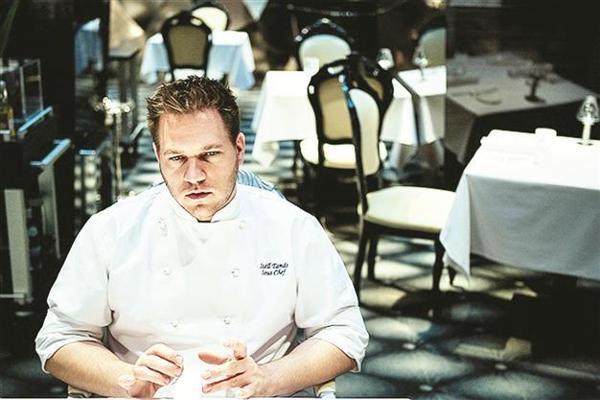Hungry for Hungary
AYLİN ÖNEY TAN - aylin.tan@hdn.com.tr


Hungarian chef, Tamas Szell, (sous-chef of the Michelin starred Onyx Restaurant), recently played with the idea of cliches.
They say “Köszönöm szepen!” We say “Teşekkür ederim!”Hungarian and Turkish must be two of the most difficult languages spoken in the European continent. I’m here in Budapest for the VinCE wine event as the only Turkish journalist from Turkey, and now I understand what it is like when in a totally alien language environment.
The wines are great, with a great range from not only Hungarian producers but with a good selection of Central European, Italian, Balkan and Eastern European wines. The workshops are flawlessly organized with excellent presenters and wine selections. As I discover more and more Central and Eastern European wines, I’m even more excited to find about what is happening in the culinary scene in Budapest.
I have a soft spot about everything Hungarian, having visited the country many times throughout the years since my first visit in 1970s. My first Hungarian experience was for the occasion of a Turkish Art History Congress, accompanying my mother, Professor Gönül Öney, who was one of the lecturers there.
I was a teenager then and my young palate fell in love with the fried breaded mushrooms and the camembert wedges, as well as the multi layered cakes like Esterhazy and the infamous Dobos Torta, of course. I could not get enough of the strudels and was struck by the idea of fruit soups being served as an entree. Later in life I visited the city as an architect and admired the wonderful architecture, enjoying both the interiors of cafés and their specialties. The Baroque interior of Ruszwurm Cukraszda matched its elaborately creamy Somloi Galuska; the pompous sugary extravagance of Dobos Torta was so suitable for the grandeur of Gerbaud; the warm cherry strudel meggyes retes was right at home with the cozy feeling of Central Café; it felt so intellectually right to sip the Hungarian sparkly Törley in the Cafehaz Muvesz, and so on.
Actually, my first ever food article to appear in a newspaper was written in Budapest when I was visiting my sister Sezin Öney for Christmas, then a student in the Central European University. All those years, the food stayed more or less unchanged, always delightful for me, but almost always the same old stuff. During my last visit about seven years ago, the hints of change were obvious. Young chefs were playing with ideas of creating new interpretations of classic Hungarian dishes and exciting new places were popping up here and there. This was an exciting change, as Hungarian cuisine was worth discovering, but usually stuck with clichés like gulyas and paprikas.
The similarities between Hungarian and Turkish cuisines are intriguing. There are about 300 Turkish loan words in Hungarian, most of them being related to food, agriculture and husbandry. You start the day with a warm pogacsa/poğaça in both countries. Fire side cooking with the special kettle, ‘bogracs’ (Bakraç in Turkish) is a Magyar tradition extending back to the times when the Central Asian-originated tribes first made their way into Europe. Gulyas, a shepherd’s dish, is a wonderful combination of Magyar roots with outside influences - as the key secret of the dish, paprika, was introduced by the Turks. Gulyas is like the kebab of Turkish cuisine. Kebabs and Gulyas, Baklava and Dobos torta; these are the unavoidable cliches. But these cliches do have a reason to be the iconic dishes. When made to perfection they’re hard to beat and can proudly represent the country.
One young Hungarian chef, Tamas Szell, (sous-chef of the Michelin starred Onyx Restaurant), recently played with the idea of cliches in a very clever way. He was the first Hungarian chef to take part in the prestigious Bocuse d’Or Competition in 2013, successfully coming in 10th place. He did not escape from the most typical Hungarian cliche dish, Gulyas, and also presented the most ubiquitous street food, Lángos, but he did both with a twist. They researched old Gulyas recipes in old books and came up with a new interpretation with a hint of orange zest and coffee flavor. Langos is the plate sized fried dough disks, sold at markets and fairs, very similar to Turkish pişi. The competition version of langos were tiny bite-size pieces served with caviar, an idea similar to serving caviar with bliny, an influence of Russian high cuisine. So the popular humble Hungarian food, probably originating from Turkish heritage, was thus elevated to a posh restaurant dish, with a wise interpretation.
The Turkish Bocuse d’Or finals took place last Saturday and chef Gürcan Gülmez, sous-chef of Four Seasons Sultanahmet, was the winner. Gülmez will now experience the same challenge as Tamas Szell.
As Turkish and Hungarian cuisines shared a lot in the past, now young chefs might share their experiences! If Tamas can give a helping hand to Gürcan, we can only say “Köszönöm szepen!”
Bite of the week
Fork of the Week: Tamas Szell and his partner, the executive
chef of Michelin starred Onyx Restaurant Szabina Szullo, have come up
with the idea of making a 21st century Somloi Galuska. A must visit in
town should be to taste the age old recipe with their futuristic
interpretation.
Cork of the Week: The traditional digestive Zwack Unicum had always been my favourite. Some regarded it as an ersatz cough syrup, but I was in love with the extreme bitterness. Now, Unicum is making challenging new products. The new Unicum Szilva has a delightful plummy fruitiness and is way lighter than the original. Plus, it is great with cocktails. To discover more about the drink world, for anybody visiting Budapest and interested in wine, VinCE Magazine is a must-have read.

